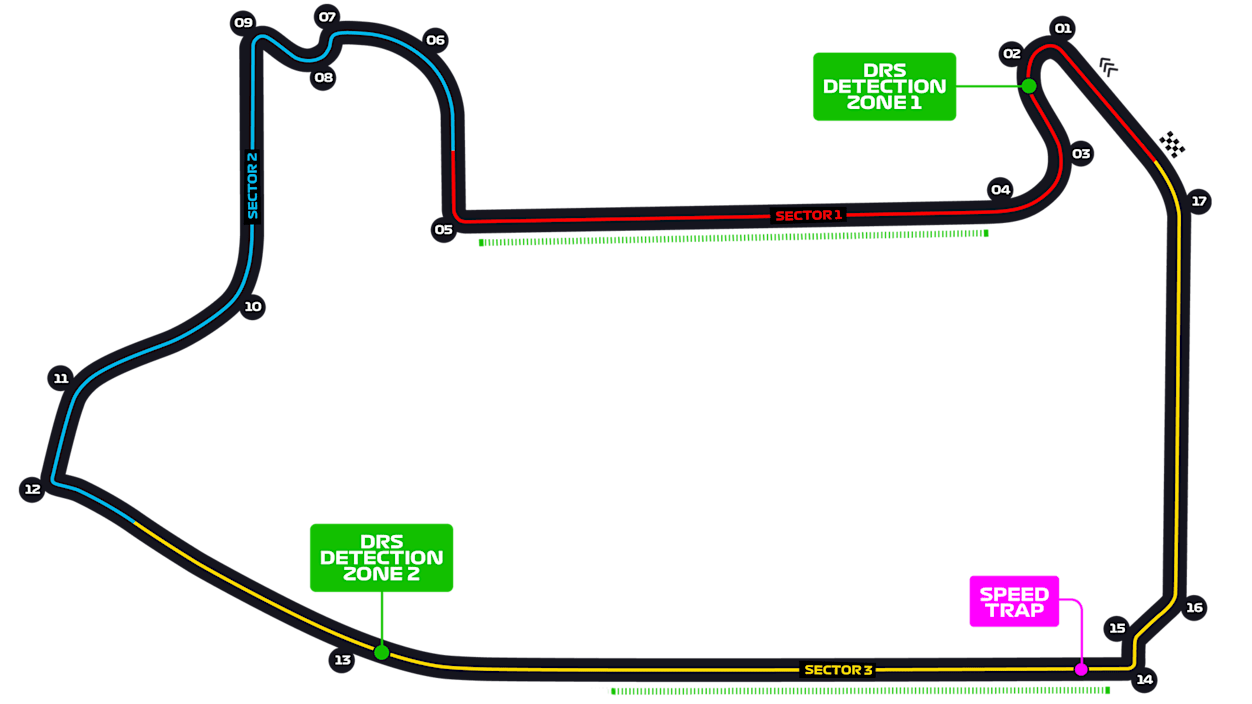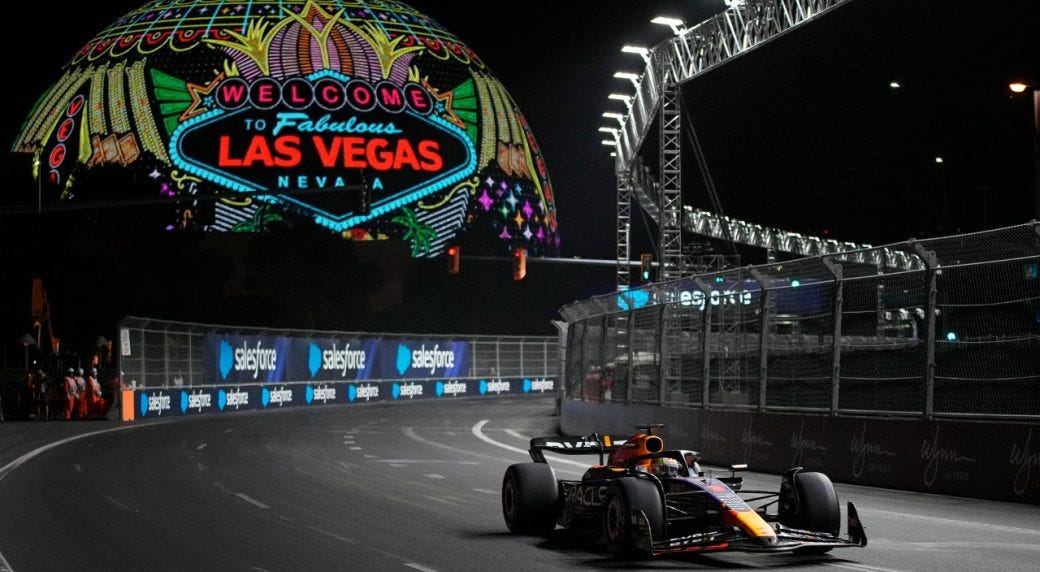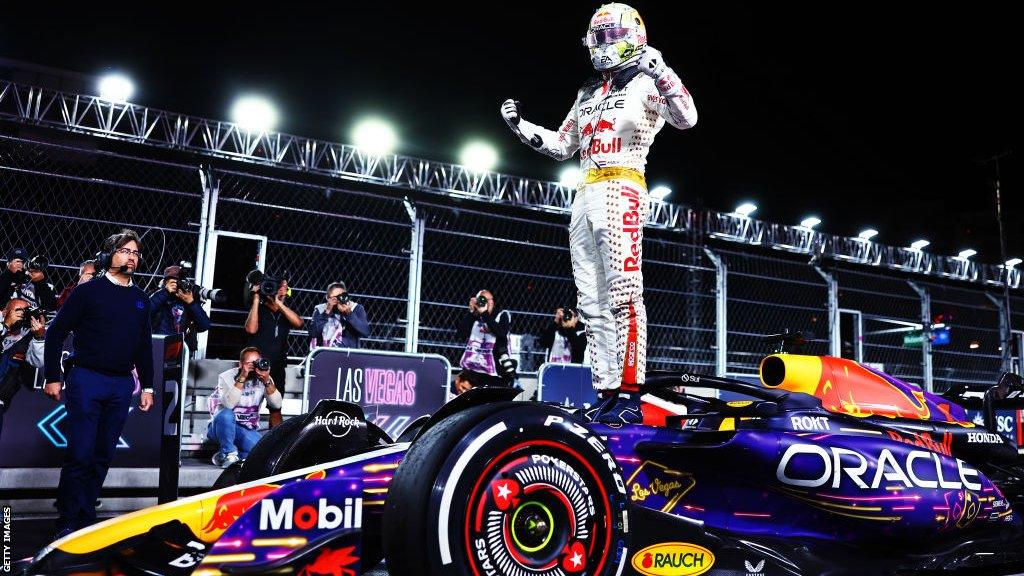
2025 Las Vegas Grand Prix: all you need to know
The 2025 Las Vegas Grand Prix is one of the most anticipated Formula 1 events of the year. Set against the iconic backdrop of the Las Vegas Strip, this night race will bring high-speed action and glitz to the desert. Getting closer to the end of the season, the stakes are high: McLaren's Lando Norris leads the championship standings, and McLaren have already clinched their second straight Constructors' title. Fans can expect a unique spectacle under the neon lights, with the world's best drivers battling on Vegas's flashy street circuit.
Key corners
The Las Vegas Strip Circuit is a 6.201 km (3.85 mi) street track featuring 17 turns that wind through the city's resort corridor. The lap begins with a tight Turn 1 hairpin, the circuit's slowest corner, which comes just seconds after the start line. This sharp left-hander is a prime overtaking spot on lap 1 and demands heavy braking and precision from the drivers.

Midway through Sector 1, the cars blast through a quick kink and into Turn 5, a 90-degree right-hander. From there, the circuit opens up into a long, sweeping left turn reminiscent of Sochi's famous Turn 3, testing drivers with sustained lateral G-forces. The most crucial corner of the lap is Turn 9, a left-hander leading onto Las Vegas Boulevard (the Strip). A strong exit out of Turn 9 is vital, as it feeds the cars onto a 1.9 km flat-out stretch down the Strip. With engines at full throttle for almost two kilometers, the drivers can exceed 340 km/h (211 mph) on this straight -- approaching speeds seen at Monza, the sport's traditional "Temple of Speed."
After this immense straight, the circuit funnels into a tight chicane and then Turn 14, a hard-braking right-hand corner at the end of the back straight. This section requires significant brake cooling and stability, as cars arrive with cold tires (after the long straight) and must slow from ~350 km/h to city-street speeds. Finally, a quick left-right sequence through Turns 15-16 leads into Turn 17, the last corner, which slingshots the cars back onto the start/finish straight. Mastering these key corners -- from the hairpin of Turn 1 to the high-speed commitment of Turn 9 and the heavy braking into Turn 14 -- will be critical for a fast lap around Vegas.

Overtaking opportunities
Despite being a street circuit, Las Vegas proved surprisingly overtaking-friendly in its debut. The track's layout creates multiple passing zones, especially at the end of its long straights. The first DRS zone leads into Turn 5, offering a chance to slipstream and out-brake a rival into that 90° right-hander. Even more significant is the run down the Strip into Turn 14 -- the longest full-throttle section where cars gain a powerful tow. With a DRS zone along this stretch as well, Turn 14 is expected to be the prime overtaking spot on the circuit. This wide braking zone invites daring moves from drivers coming off that 1.9 km straight.
Notably, the inaugural Las Vegas GP saw an abundance of passes up and down the field. In fact, the 2024 race featured over 180 on-track overtakes, showcasing how a combination of long straights and heavy braking zones can produce exciting wheel-to-wheel action. Back in 2023, McLaren's Oscar Piastri alone pulled off 20 overtakes during the race weekend, underlining the opportunities this circuit provides for drivers to fight through the pack. Fans can look forward to plenty of side-by-side duels, with Turn 1 (at the race start), Turn 5, and especially Turn 14 likely to be the scenes of bold passing maneuvers.

Tyre selection and strategy
Pirelli is bringing the softest tire compounds in its range to Las Vegas, a choice typical for new or less abrasive street circuits. Teams will have the Pirelli C3 compound as the hard tire, C4 as the medium, and C5 as the soft -- the same selection used in Las Vegas's previous races. This softest allocation is intended to maximize grip on the smooth asphalt and help tires heat up in the cool night conditions. Each driver is expected to have two sets of hards, three mediums, and eight softs available for the weekend.
The biggest challenge will be tire warm-up, especially for the front tires. Because the Grand Prix is run at night, track temperatures will be low, and the long straights allow tire surface temperatures to drop significantly. "Drivers will have to be careful to bring the tyres up to temperature without overworking them," Pirelli notes, emphasizing the need to avoid lock-ups at the heavy braking zones (like Turn 14) where cold tires can easily slide. Low ambient temperatures also reduce grip and can cause increased graining, as the tires struggle to stay in their optimum window. This was a factor in 2023, where many teams experienced front tire graining in the cool desert night.

In terms of strategy, teams are eyeing a two-stop race as the likely fastest approach in Las Vegas. Last year's Grand Prix saw the majority of drivers make two pit stops due to tire wear from graining and the challenge of keeping the compounds in their ideal temperature range. A typical strategy might involve starting on the medium tire and switching to hards, or even making two stints on the hard compound if degradation is manageable. However, a one-stop strategy could still be viable for those who can carefully manage their rubber -- by gradually building tire temperature and avoiding early push, a driver might stretch a single pit stop to cover the race distance. Notably, an undercut (pitting early to gain track position) is considered less effective here; with cold out-laps and slow warm-up, coming in too early can backfire, whereas running longer on warmer tires might be the better approach. Teams will also be mindful of the high likelihood of Safety Cars or red flags on a street circuit, which could throw off the planned strategies and force some reactive calls on pit wall.
Weather outlook and its impact
One of the quirks of the Las Vegas GP is the desert weather in late November. While Las Vegas days can be mild, the nighttime temperatures can drop to single digits (°C) during race week. In 2023, teams faced unusually cold conditions with air temperatures around 10--15°C (50--60°F) during the sessions -- far cooler than a typical F1 event. For 2025, forecasts again predict chilly evenings, potentially making this one of the coldest races on the calendar. The desert air loses heat quickly after sunset, so by the late-night race start (10 PM local time) teams could be dealing with track temperatures in the low teens or even high single digits Celsius.

Cold weather will heavily influence car setup and performance. Tire warm-up, as discussed, is directly impacted -- teams may adjust camber and pressure settings to help generate heat, and some might alter aerodynamic setup (for example, adding a bit more downforce than a pure top-speed setup) to put more load into the tires. Brake warm-up is another concern; drivers will do vigorous weaving and heavy braking on formation laps to build heat in brakes and tires. Engine and gearbox temperatures should be less of a worry in the cold, but teams must ensure they don't fall below optimal operating temps during safety car periods in chilly air.
On the positive side, cooler air is denser, which can slightly boost engine performance and provide better aerodynamic downforce. However, it also means more drag on the long straights, so the net effect on top speeds may balance out. As for precipitation, Las Vegas's desert climate makes rain highly unlikely -- the historical chance of rain in late November is very low. Barring an unexpected desert shower, teams likely won't need intermediate or wet tires at all. Instead, the focus will remain on dealing with the cold and perhaps gusty desert winds. Overall, the weather in Vegas will test teams' ability to adapt to conditions that are a world apart from the heat of places like Singapore or Abu Dhabi.
Historical records and statistics
Although the 2025 Las Vegas Grand Prix is only the third F1 race on this circuit, the city has some Formula 1 history. Las Vegas first hosted F1 in the early 1980s with two races (1981 and 1982) held in the Caesars Palace parking lot. Those tight, temporary tracks saw Alan Jones win in 1981 and Michele Alboreto in 1982. After that brief stint (dubbed the Caesars Palace Grand Prix), F1 left Vegas for decades -- until the glittering return on a brand-new street circuit in 2023.

The modern Las Vegas Strip Circuit debuted in 2023 and immediately delivered memorable stats and moments. Max Verstappen won the inaugural 2023 Las Vegas Grand Prix for Red Bull, with Charles Leclerc and Sergio Pérez completing the podium. In 2024, the race produced a different winner: George Russell took victory for Mercedes, ahead of teammate Lewis Hamilton and Ferrari's Carlos Sainz. (Notably, Max Verstappen clinched his 2024 drivers' title during the Las Vegas weekend, even though he finished fifth in that race.) This means we've had two editions with two different winning teams -- adding intrigue as to who might triumph in 2025.
The circuit itself has already set some impressive benchmarks. The official lap record stands at 1:34.876, set by Lando Norris in 2024 during an adrenaline-fueled chase for fastest lap. In 2023, Oscar Piastri had set a 1:35.490 as the benchmark, which Norris managed to beat the following year. Top speeds have been eye-opening as well: the speed trap record in Las Vegas is 229.3 mph (369 km/h), achieved by Alex Albon in 2024 down the massive Strip straight. This makes Las Vegas one of the fastest circuits in F1 in terms of pure top-end velocity. For perspective, only Monza and a couple of other tracks see similar speeds.

Other notable stats include the sheer volume of overtakes (181 passes in the 2024 race, as noted earlier) and the fact that Las Vegas's layout is the second-longest on this year's calendar after Spa-Francorchamps. At 6.2 km, it just edges out Jeddah as a lengthy street venue. The race is scheduled for 50 laps, giving a total distance of about 310 km, which is standard for a Grand Prix. With two races in the books, the Vegas GP has already delivered a Saturday-night festival atmosphere, complete with an opening ceremony extravaganza and off-track entertainment that rivals Monaco in glitz. Yet it's also produced serious racing and unpredictability -- a combination that has quickly made it a favorite among fans.
Conclusion
The 2025 Las Vegas Grand Prix promises to be a thrilling blend of technical racing and showbiz excitement. We've highlighted the key corners where the race could be won or lost, the likely overtaking zones that will get fans on their feet, and the tire and weather factors that teams must master under unique desert night conditions. With the world championship nearing its climax, all eyes will be on the Las Vegas Strip as F1's stars dice at 200+ mph past casinos and landmarks. Historical trends suggest we could see another dramatic race -- perhaps even a new winner -- under the lights of Sin City. Whether you're a tech-focused fan analyzing sectors and strategies, or an enthusiast soaking in the spectacle, the Las Vegas Grand Prix offers something for everyone. Get ready for a high-stakes night in Vegas -- a fitting stage for Formula 1's grand finale run-up, where fortunes on track can change as quickly as a roll of the dice.
